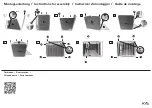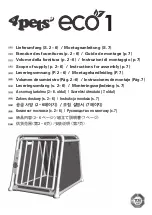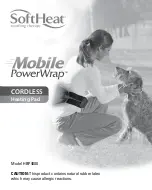
Chapter 9: GRAPHIC SYMBOLS
1.
Equipment capable of delivering output values in excess of
10mA r.m.s. or 10V r.m.s. averaged over any period of 5s.
2.
Type BF applied part.
3.
Do not insert the plug into AC power supply socket.
4.
Direct Current (DC power source)
5.
Refer to Instruction Manual.
Chapter 10: PARAMETER CONTROLS
PUSLE DURATION
Wider Pulse Duration settings will deliver stronger stimulation for any given intensity
setting. As mentioned in the Controls Section, by using a combination of intensity
and pulse duration, it is felt that various pulse widths are capable of stimulation
different groups of nerve fibers.
The choice of which pulse duration to use is partially dependent upon the Treatment
Mode and Protocol selected (refer to the appropriate section).
PULSE RATE
The Pulse Rate (hertz or pulses per second) chosen depends greatly upon the type
of electrode placement given to the patient.
When using contiguous and dermatome electrode placements (i.e. stimulating
directly through the area of pain or localized enervation), a quick pulse rate (setting
greater than 80Hz on the Pulse Rate Control) is desired. The patient should not
perceive individual pulses but rather have the sensation of steady continuous
stimulation.
Despite above recommendations, these individual patients may require slight
variations of the above settings, according to the nature of their condition.
TREATMENT MODE
Normal or Conventional TENS offers the practitioners complete control over all the
various treatment parameters of the instrument.
Burst Mode is analogous to the Low Rate TENS technique except the low frequency
individual pulses are replaced by individual "bursts" of 7-10 individual pulses. It is
thus a combination of Conventional TENS and Low Rate TENS. In Burst Mode,
the treatment frequency is fixed by the instrument and is not adjustable with the
Frequency Rate control.
Modulated Mode attempts to prevent nerve accommodation by continuously cycling
the treatment intensity. When using Modulated Mode increase the intensity only
when the unit is at the maximum intensity of the modulation cycle. If the intensity
is increased during a low intensity period of the cycle, the patient may turn up the
control very slowly, so that they may feel the intensity any higher.
TIME DURATION
The onset of pain relief should occur shortly after the intensity setting has been
determined. However, in some cases, pain relief may take as long as 30 minutes to
achieve. TENS units are typically operated for long periods of time, with a minimum
of 20 - 30 minutes and in some post-operation protocols, as long as 36 hours.
In general, pain relief will diminish within 30 minutes of the cessation of stimulation.
8
9








































